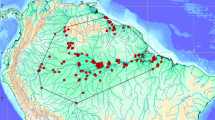Summary
The marine pelagic tunicate Thalia democratica has one of the fastest individual growth rates and shortest generation times of any multicellular animal. Measurements of growth in the laboratory and at sea show that this salp maintains a growth rate of over ten percent in length per hour for much of its life cycle. This salp develops through bot generations in a minimum of two days. This generation time increases to over two weeks under conditions of poorer food or lower temperature. Maternal nutrition and viviparity are among the many specialized adaptations which allow this animal to achieve such rapid growth.
Similar content being viewed by others
References
Andrewartha, H. G., Birch, L. C.: The distribution and abundance of animals. Chicago: Chicago University Press 1954.
Berrill, N. J.: The tunicata. London: Ray Society 1950.
Braconnot, J. C.: Etude du Cycle Annuel des Salpes et Dolioles en Rade de Villefranche-sur-Mer. J. Cons. Perm. Int. Expl. Mer 28, 21–36 (1963).
Carlisle, D. B.: Alcune osservazioni sulla meccanica dell alimentazione della Salpa. Pubbl. Staz. zool. Napoli 22, 146–154 (1950).
Cole, L. C.: The population consequences of life history phenomena. Quart. Rev. Biol. 29, 103–137 (1954).
Fleminger, A., Clutter, R. I.: Avoidance of towed nets by zooplankton. Limnol. Oceanogr. 10, 96–104 (1965).
Foxton, P.: The distribution and life-history of Salpa thompsoni Foxton with observations on a related species Salpa gerlachei Foxton. Discovery Rep. 34 1–116 (1966).
Heinle, D. R.: Production of a calanoid copepod, Acartia tonsa, in the Patuxent River estuary. Chesapeake Sci. 7, 59–74 (1966).
Heron, A. C.: A dark-field condenser for viewing transparent plankton animals under a low-power stereomicroscope. Marine Biol. 2, 321–324 (1969).
Heron, A. C.: Population ecology of a colonizing species: the pelagic tunicate Thalia democratica. II. Population growth rate and intrinsic rate of increase. Oecologia (Berl.) 10, 294–312 (1972).
Humphrey, G. F.: Seasonal variations in plankton pigments in waters off Sydney. Aust. J. mar. Freshwat. Res. 14, 24–36 (1963).
Leloup, E.: La maturation et la fecondation de l'ocuf de Salpa fusiformis Cuvier. Bull. Acad. R. Belg. Cl. Sci. (5) 15, 461–478 (1929).
Lewontin, R. C.: Selection for colonizing ability. In: Baker, H. G., Stebbins, G. L., (eds.), The genetics of colonizing species. New York: Academic Press 1965
McGowan, J. A., Fraundorf, V. J.: The relation between the size of net used and estimates of zooplankton diversity. Limnol. Oceanogr. 11, 456–469 (1966).
Mullin, M. M., Brooks, E. R.: Laboratory culture, growth rate, and feeding behaviour of a planktonic marine copepod. Limnol. Oceanogr. 12, 657–666 (1967).
Murphy, G. I.: Pattern in life history and the environment. Amer. Naturalist 102, 391–403 (1968).
Sheard, K.: Species groups in the zooplankton of eastern Australian slope waters, 1938–41. Aust. J. mar. Freshwat. Res. 16, 219–254 (1965).
Simberloff, D. S.: Experimental zoogeography of islands: a model for insular colonization. Ecology 50, 296–314 (1969).
Thompson, H.: Pelagic tunicates in the plankton of south-eastern Australian waters and their place in oceanographic studies. Bull. Coun. sci. industr. Res. Aust. 153, 1–56 (1942).
Thompson, H.: Pelagic tunicates of Australia. Melbourne: Coun. sci. industr. Res. Aust. 1948.
Volkmann, G., Knauss, J. A., Vine, A. C.: The use of parachute drogues in the measurement of subsurface ocean currents. Trans. Amer. Geophys. Union 37, 573–577 (1956).
Watt, K. E. F.: Comments on fluctuations of animal populations and measures of community stability. Canad. Ent. 96, 1434–1442 (1964).
Zilloux, E. J., Wilson, D. F.: Culture of a planktonic calonoid copepod through multiple generations. Science 151, 996–998 (1966).
Author information
Authors and Affiliations
Rights and permissions
About this article
Cite this article
Heron, A.C. Population ecology of a colonizing species: The pelagic tunicate Thalia democratica . Oecologia 10, 269–293 (1972). https://doi.org/10.1007/BF00345733
Received:
Issue Date:
DOI: https://doi.org/10.1007/BF00345733




